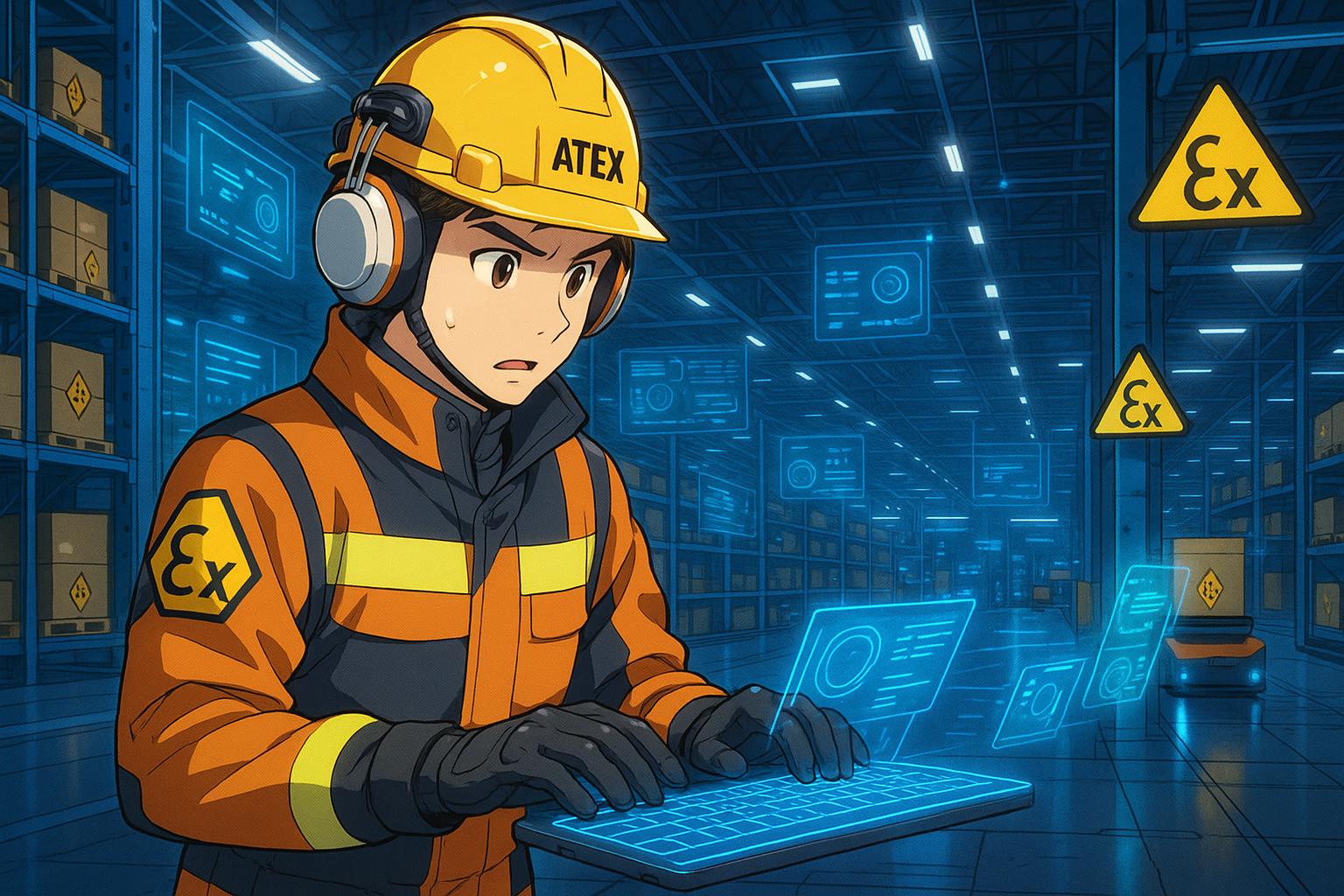As European fulfilment centres face stringent ATEX regulations governing explosive atmospheres, new rugged and compliant devices like the Ex BT-Key-02 wireless keyboard are revolutionising worker safety without sacrificing operational efficiency.
The emergence of e-commerce and the consequent growth of fulfilment centres have transformed retail logistics, but these hubs also face significant safety challenges, particularly under ATEX (Atmosphères Explosibles) regulations in Europe. These regulations govern environments where explosive gases or dust may be present, classifying them into specific zones. For instance, Zone 2 refers to areas that may occasionally experience explosive gas atmospheres, while Zone 22 addresses similar concerns regarding dust. This classification is critical in ensuring the safety of workers and equipment in environments such as ventilated battery storage areas, electric vehicle docking bays, and loading zones within fulfilment centres.
The importance of adhering to ATEX classifications cannot be overstated, particularly as logistics operations become increasingly sophisticated and storied. Non-compliance can lead to not only regulatory penalties but also jeopardise the safety of workers, potentially resulting in catastrophic incidents. For example, devices like tablets, radios, and barcode scanners may inadvertently ignite explosive atmospheres if they are not designed specifically for hazardous areas. Notably, a hot surface or a minor electrical failure within a device, even if it is sealed, has the potential to ignite gases or dust particles under the right conditions. Consequently, the industry requires specialty electronics that can withstand these environments without compromising safety.
Addressing these challenges requires the integration of explosion-proof accessories and innovative technology tailored for hazardous settings. One solution gaining traction is the Ex BT-Key-02, a wireless keyboard that meets the standards for Zones 2 and 22. This device not only allows for seamless Bluetooth connectivity with various certified electronics but is also engineered to endure harsh conditions, being resistant to dust, water, and corrosive substances. With an impressive durability rating of over ten million keystrokes, it promises reliable performance while ensuring worker safety.
Furthermore, the ergonomic design of such equipment is crucial for labour efficiency. As workers are increasingly mobile, the need for lightweight, easy-to-transport devices becomes evident. A long battery life and compatibility with multiple operating systems further enhance the utility of devices like the Ex BT-Key-02, integrating them effortlessly into contemporary digital workflows.
As the logistics landscape evolves to incorporate advanced technologies, the intersection of safety and operational efficiency will continue to shape the future of fulfilment centres. The integration of high-density energy storage systems and e-mobility components inherently raises the risk of combustible atmospheres, emphasising that the responsibility for worker safety must never be sidelined. Tech leaders within retail operations must thus prioritise compliance with ATEX regulations, not merely as a legal obligation but as a core aspect of operational integrity.
The warehouse of 2025 promises to revolutionise logistics, prioritising both speed and safety. The tools placed in the hands of workers will be pivotal in achieving this dual goal, underscoring the imperative that safety innovation can and should go hand in hand with technological advancement.
Reference Map
- Paragraph 1: [1], [2], [3]
- Paragraph 2: [1], [7]
- Paragraph 3: [1], [4], [5]
- Paragraph 4: [1], [5], [6]
- Paragraph 5: [1], [6], [7]
- Paragraph 6: [1], [2], [6]
Source: Noah Wire Services
- https://retailtechinnovationhub.com/home/2025/5/20/why-your-fulfilment-centre-might-be-a-certified-hazard-area-and-what-tech-needs-to-change – Please view link – unable to able to access data
- https://www.hazardex.com/define/zones – This article defines hazardous zones based on the frequency and duration of explosive atmospheres. It outlines classifications for gas zones (0, 1, 2) and dust zones (20, 21, 22), detailing the conditions under which each zone applies. The piece emphasizes the importance of proper zone classification for implementing appropriate safety measures and equipment selection in hazardous environments.
- https://www.hsa.ie/eng/topics/atex/ – The Health and Safety Authority provides detailed information on ATEX regulations, focusing on the risk from explosive atmospheres and the necessary precautions in workplaces. The article explains the classification of hazardous areas into zones 20, 21, and 22 for dusts, specifying the conditions under which explosive dust atmospheres are present and the required safety measures.
- https://www.njzlighting.com/lighting-industry/hazardous-location-zones.html – This article defines hazardous locations in North America, detailing the classification of zones 0, 1, and 2 for explosive gas atmospheres. It provides insights into the conditions under which each zone applies and the corresponding safety requirements, emphasizing the need for appropriate equipment and safety measures in these environments.
- https://www.seton.co.uk/industries/warehouse-logistics/understanding-atex-explosive-atmosphere – Seton offers an understanding of ATEX zone classifications, focusing on the assessment and management of risks to promote workplace safety. The article explains the classification of hazardous areas into zones 0, 1, and 2 for gases, mists, and vapours, and zones 20, 21, and 22 for dust, detailing the duration and conditions under which explosive atmospheres are present.
- https://www.electricalandcontrol.com/hazardous-locations-classifications/ – This article discusses hazardous location classifications, focusing on the ATEX zone system for gases, vapors, and mists. It outlines the definitions of zones 0, 1, and 2, specifying the likelihood and duration of explosive atmospheres in these zones. The piece also touches upon the equipment categories suitable for each zone, emphasizing the importance of proper equipment selection for safety.
- https://intrinsicallysafestore.com/blog/explosive-zones/ – The Intrinsically Safe Store provides an overview of explosive zones, detailing the classifications for gas and dust environments. The article explains zones 0, 1, and 2 for gases, and zones 20, 21, and 22 for dust, specifying the conditions under which explosive atmospheres are present. It emphasizes the importance of using intrinsically safe and explosion-proof equipment to prevent ignition in these hazardous areas.
Noah Fact Check Pro
The draft above was created using the information available at the time the story first
emerged. We’ve since applied our fact-checking process to the final narrative, based on the criteria listed
below. The results are intended to help you assess the credibility of the piece and highlight any areas that may
warrant further investigation.
Freshness check
Score:
8
Notes:
The narrative mentions current issues and technologies relevant to 2025, indicating freshness. However, ATEX regulations are not new, which might suggest some repetition of existing information.
Quotes check
Score:
10
Notes:
There are no direct quotes in the narrative, so there is no risk of plagiarism and no need to verify any quotes.
Source reliability
Score:
6
Notes:
The narrative originates from a specific innovation hub, which may not be as widely recognized as major news outlets. While it appears to present technical information, its reliability is uncertain compared to well-established sources.
Plausability check
Score:
9
Notes:
The claims about ATEX regulations and safety in fulfilment centres are plausible and align with known safety standards. The integration of specialized technology like the Ex BT-Key-02 is consistent with industry needs.
Overall assessment
Verdict (FAIL, OPEN, PASS): OPEN
Confidence (LOW, MEDIUM, HIGH): MEDIUM
Summary:
The narrative is fresh and plausible, addressing current safety concerns in fulfilment centres. However, the source is not as established as major news outlets, which affects its reliability. The lack of direct quotes and the relevance of the information support its credibility, but more verification is needed regarding the source’s standing.













